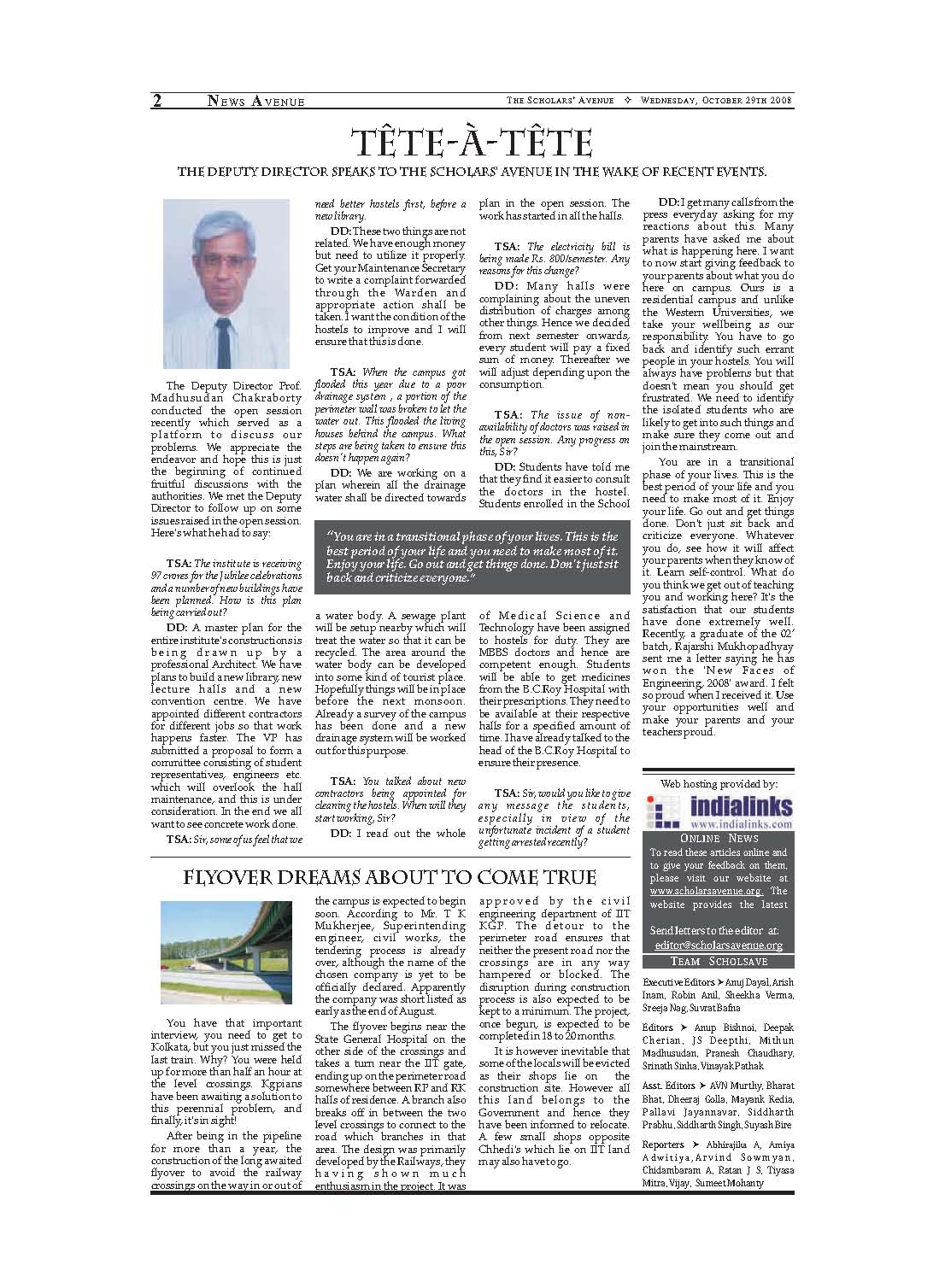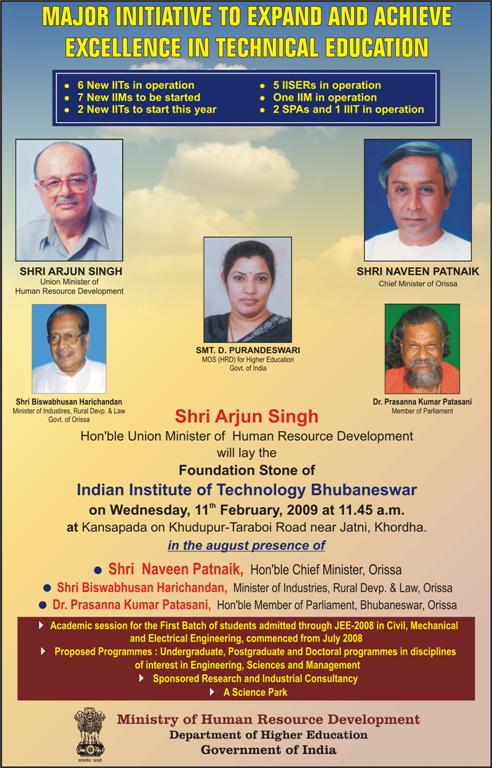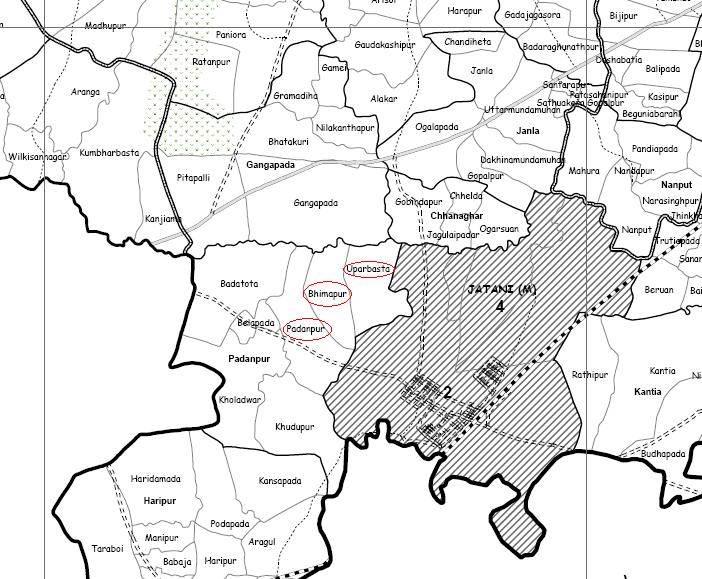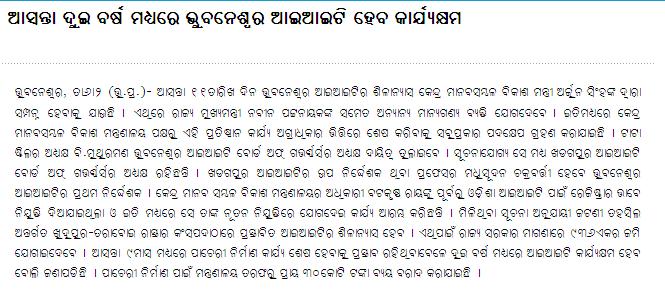Following is an excerpt from a report in the Times of India.
A typographical error, it seems, has become a boon for the state. The Centre on Wednesday assured the state of an IIM, which was announced earlier, but termed as a “typographical mistake” made by the union HRD ministry.
“The HRD ministry has rectified the mistake. As announced, we will now take action to set up an IIM in Rajasthan also,” acting finance minister Pranab Mukherjee said in Rajya Sabha on Wednesday. In the recent budget speech, Mukherjee had said that the new Indian Institutes of Management (IIMs) were to come up in Haryana, Rajasthan, Jharkhand and Tamil Nadu.
However, Mukherjee later said he was informed that there was a typographical mistake made by the HRD ministry and these institutions were to come up in Haryana, Chhattisgarh, Jharkhand and Tamil Nadu.
This, however, led to strong protests in Rajasthan and MPs from the state raised the issue in the ongoing session of Parliament.
Mukherjee’s latest announcement has now put to rest the controversy over the IIM as the main opposition BJP was in a mood to make it a poll issue in the state. In fact, after the recent victory in assembly polls, the Congress high command has been heavily banking on Rajasthan and the party didn’t want to antagonise the voters of the state on the eve of Lok Sabha polls.
February 26th, 2009
Following is an excerpt from a report in Indian Express. (My guess is that this is just a warning.)
The indiscipline and frequent unrest on the campus have cost the Bengal Engineering and the Science University (BESU) the central status of Indian Institute of Engineering Science and Technology (IIEST).
The ministry of Human Resource and Development has sent a regret letter, saying the university cannot be upgraded.
The letter, sent to the university chancellor, Governor Gopalkrishna Gandhi, conveyed that the status is being denied on two grounds: The university administration is in shambles, it said, and unless things improve, the Centre will not consider upgradation.
The second reason is that the expenditure finance report of the university was not satisfactory.
The university was asked to submit the report on how it would spend the money allocated in the 11th plan period.
For the past two years, the institute has been rocked by violence and frequent protests by teachers and non-teaching staff. The students were asked twice to vacate the campus, which was closed for an indefinite period.
… The Anadakrishnan Committee had recommended six institutes along with BESU for the IIEST status. According to university sources, it was in the top slot.
On December 31, 2007, a letter was sent to the state’s chief secretary from the Centre, which said BESU will be upgraded.
Teachers are taken aback by the developments.
…The decision also begs why the ministry did not inform the state government before taking the decision. Students are in shock as well.
“Instances of campus unrest are not good for the image of a campus. But that it would cost us the much-awaited central status is a shock,” said a student.
The institute will miss
* Rs 519 crore in the plan period and recurring Central grants
* Status at par with the IITs
* Developments in campus infrastructure
* BTech and MTech programmes
February 22nd, 2009
Following is from a report by PIB.
The Government has decided to set up 20 counter-insurgency and Anti-Terrorism Schools during the XIth Plan. It is proposed to locate 4 schools each in the states of Assam, Bihar, Chhattisgarh, Jharkhand and Orissa with a view to providing training to the State police personnel to tackle the insurgency/naxal menace.
February 17th, 2009
The six new IITs that started classes last year are:
Here are some observations regarding visible progress with respect to these IITs.
February 15th, 2009
Following is the main contact person for IIT Bhubaneswar:
Bata Kishore RAY
Registrar
IIT Bhubaneswar
Samantapuri
(Behind Hotel Swosti Plaza)
Nandan Kanan Road
BHUBANESWAR-751 013
Tel: 91-674-2301982
Fax: 91-674-2301983
Email: iitbhubaneswar@yahoo.com
Web: www.iitbbs.ac.in
Beyond the above, the other names associated with IIT Bhubaneswar are:
- Director Designate: Prof. Madhusudan Chakrabarti
- Mentor Director: Prof. Damodar Acharya
- Chairperson of BOG (Board of Governors): B. Muthuraman (MD of Tata Steel)
February 12th, 2009
Following is from the PIB report http://pib.nic.in/release/release.asp?relid=47448.
| Foundation Stone of Indian Institute of Technology, Bhubaneswar, laid
TO ACT AS A CATALYST FOR THE RAPID INDUSTRIALIZATION OF THE STATE
|
| |
15:15 IST |
Foundation Stone of the Indian Institute of Technology ( IIT ), Bhubaneswar, was laid in Orissa today. Shri Arjun Singh, Union Minister of Human Resource Development, was to lay the Foundation Stone, but due to unavoidable reasons he couldn’t go to Orissa and the ceremony was held in his absentia at KANSAPADA ( Khudupur-Taraboi Road ) near Jatni Block Office, Khordha.
This new IIT at Bhubaneswar is part of the 8 new IITs that have been established in the country by the Union Ministry of Human Resource Ministry. Orissa is also to get a new Central University under The Central Universities Ordinance, 2009 which was promulgated by the President of India on 15.01.2009.
Following is the full text of the speech of Shri Arjun Singh, delivered on his behalf :
“ IITs are our national pride and owe their existence to the scientific temper and disposition of our First Prime Minister Pt. Jawahar Lal Nehru. Making India, the knowledge hub of the world was a cherished dream of our first Prime Minister Pt. Jawahar Lal Nehru. Way back in 1951, the Government of India, under the leadership of Panditji, planned to have four such institutes of excellence in the field of Engineering and Technology. The first amongst four such institutes (one for each zone) came up at Kharagpur in eastern region.
During the Eleventh Plan Period, the Government of India has decided to have eight new IITs, including IIT Bhubaneswar. IIT Bhubaneswar was one of the new IITs to become operational with 120 students in July, 2008. It is also heartening to note that the mother of the IIT system, IIT Kharagpur, is mentoring this new IIT. I would like to compliment Prof. Damodar Acharyaji, Director, IIT, Kharagpur who has made all possible efforts to mentor this IIT. The necessary facilities are being created in IIT Kharagpur Extension Campus at Bhubaneswar so that the students of IIT Bhubaneswar could have their education from Bhubaneswar itself from the forthcoming academic session starting from July 2009. IIT Bhubaneswar will offer science based engineering graduate, postgraduate and doctoral programmes of international standard in various disciplines.
The State of Orissa is a resource-rich state and we expect that IIT, Bhubaneswar will act as a catalyst for the rapid industrialization of the State. Indian Institutes of Technology are known the world over for imparting quality and relevant education to students. I am confident that this new IIT also carry forward the great tradition of IITs.
I am happy to note that the Government of Orissa has allotted 935 acres of land for this IIT. The State Government has also agreed to provide adequate facilities of water, electricity and road connectivity. I appreciate the support of the Government of Orissa to have this IIT in Bhubaneswar and would like to specially thank Shri Naveen Patnaikji for his support for the venture.
I take this opportunity to mention that we had made an assessment of various States about availability of degree and diploma level courses per lakh population in the field of technical education. We find that the availability of degree and diploma level courses per lakh population in Orissa is much below the national average. This obviously means that the regional imbalance in respect of technical education needs to be corrected. It is in this context that the setting up of an IIT in Bhubaneswar is a right and timely step. I am sure the Government of Orissa will derive maximum benefits from the Central Government schemes for educational advancement of this State.
The Government of India in its Eleventh Plan has given a major thrust to education. The Central Government has taken several initiatives in respect of new institution building. These include setting up of 30 new Central Universities, Indira Gandhi National Tribal University, eight new IITs, seven new Indian Institutes of Management (IIMs), five new Indian Institutes of Science Education and Research (IISERs), two new Schools of Planning & Architecture (SPAs), 10 new National Institutes of Technology (NITs) and 20 new IIITs. For this unprecedented expansion, the credit goes to the Hon’ble Prime Minister, who has been kind enough to accord very high priority to the education sector and provided a nine fold increase in the budgetary outlays for the higher education during the XIth Plan as compared to Xth Plan.
Capacity building in the diverse fields of basic science, engineering and technology, architecture, management will empower besides providing opportunities to the youth. It has been decided to launch a massive National Initiative for Skill Development under which it is proposed to give assistance for the establishment of 1000 new polytechnics. It is also proposed to upgrade infrastructure facilities of existing diploma level Government and Government aided polytechnics. In order to attract women in polytechnic education, we are proposing to provide financial assistance for the construction of women’s hostels in 500 polytechnics.
The Government is also going to incentivise the States for starting new Universities, besides giving a one time grant to the States on a matching basis to develop the infrastructure of State technical institutions. With these initiatives, we hope to increase access (by 5% GER during XI Plan) with equity and excellence.
8. I am happy to say that the State of Orissa is also getting its due share. We have decided in this Plan Period to have in Orissa State, one Central University, one National University aiming for world class standards, one IIIT, and several Polytechnics in those districts which currently do not have a Polytechnic. The Government and Private Engineering Colleges will also be getting opportunity to upgrade their facilities through TEQIP. This will provide our youth in the State with vocational and professional educational opportunities to realize their full potential.”
————————–
KKP/ska
February 12th, 2009
In Section 8.44 (page 174) of Volume 1 (Inclusive Growth) of the 11th Five Year Plan, the following is mentioned.
The DAE has also initiated the process for establishment of the NISER at Bhubaneswar, at par with the IISER to undertake integrated five-year Masters’ courses and integrated M.Sc–Ph.D. programme in core and emerging branches of science to provide world-class education to students.
February 10th, 2009
(The PIB report is at http://pib.nic.in/release/release.asp?relid=47274.)
The following is excerpted from a report in Hindu.
The Union Cabinet on Thursday approved two more AIIMS-like medical institutions, one in West Bengal and the other in Uttar Pradesh, at a cost of Rs.823 crore each. The Cabinet also decided to upgrade five government medical colleges in five States to the level of the All-India Institute of Medical Sciences in New Delhi.
Announcing this, Union Home Minister P. Chidambaram said: “The proposed institution in West Bengal will come up at Raiganj in North Dinajpur district. The site for the AIIMS-like college and hospital in UP has not yet been identified.”
Raiganj is represented in the Lok Sabha by the ailing Union Minister Priyaranjan Dasmunsi.
Each institution, to be set up under the second phase of the Pradhan Mantri Swasthya Suraksha Yojna (PMSSY), will have a 960-bed hospital and will provide health care facilities in 39 speciality or super-speciality disciplines.
There will be 500 beds for the medical college hospital, 300 for speciality or super-speciality, 100 for ICU or accident trauma, 30 for physical medicine and rehabilitation and 30 beds dedicated to Ayush (Ayurvedic, Unani, Siddha, Homoeopathy).
The medical college will have a hundred under-graduate intake, besides facilities for imparting post-graduate or doctoral courses and a nursing college.
The Cabinet also approved upgrading of the government medical colleges in Amritsar (Punjab), Tanda (Himachal Pradesh), Madurai (Tamil Nadu), Nagpur (Maharashtra) and Jawaharlal Nehru Medical College of Aligarh Muslim University.
The upgrading of each of these medical colleges will be done at an estimated cost of Rs.150 crore. Of this, the Centre will contribute Rs.125 crore and a minimum of Rs.25 crore will be borne by the respective State governments.
In respect of Aligarh Muslim University, Rs.25 crore will be provided by the Union Ministry of Human Resource Development.
With these additions to the earlier list the state wise distributions of AIIMS and the proposed institutes are as follows:
| State |
New or existing AIIMS or AIIMS-like Institute and location [1 + 8 ]
|
Upgradation [13 + 5] |
| Delhi |
AIIMS, Delhi |
|
| Orissa |
Bhubaneswar |
|
| Bihar |
Patna |
|
| Madhya Pradesh |
Bhopal |
|
| Uttarakhand |
Rishikesh |
|
| Rajasthan |
Jodhpur |
|
| Chhatisgarh |
Raipur |
|
| West Bengal |
Raiganj (North Dinapur dist) |
Kolkata Medical College |
| Uttar Pradesh |
Place not decided |
Sanjay Gandhi Post Graduate Institute of Medical Sciences, Lucknow
Institute of Medical Sciences, BHU, Varanasi
Jawaharlal Nehru Medical College of Aligarh Muslim University (Phase 2)
|
| J & K |
|
Govt. Medical College, Jammu.
Govt Medical College, Srinagar
|
| Andhra Pradesh |
|
Nizam Institute of Medical Sciences, Hyderabad
Sri Venkateshwara Institute of Medical Sciences, Tirupati
|
| Tamil Nadu |
|
Govt. Medical College, Salem
Govt. Medical College, Madurai (Phase 2)
|
| Jharkhand |
|
Rajendra Institute of Medical Science (RIMS), Ranchi |
| Gujarat |
|
B.J. Medical College, Ahmedabad |
| Karnataka |
|
Bangalore Medical College, Bangalore |
| Maharashtra |
|
Grant Medical College & Sir J.J. Group Of Hospitals, Mumbai
Govt. Medical College, Nagpur (Phase 2)
|
| Kerala |
|
Medical College, Thrivananthapuram |
| Punjab |
|
Govt Medical College, Amritsar (Phase 2) |
| Himachal Pradesh |
|
Govt Medical College, Tanda (Phase 2) |
| Assam, Arunachal Pradesh, Manipur, Meghalaya, Mizoram, Nagaland, Sikkim, Tripura, Goa, Haryana, |
|
|
February 6th, 2009
Among the founding directors of all the new IITs, the founding director of IIT Bhubaneswar, Prof. Madhusudan Chakrabarti, seems to have the most administrative experience. His following interview to the IIT Kharagpur Scholars Avenue magazine shows his involvement in the expansion activities at IIT Kharagpur. It also shows his experience in dealing with tough issues.

February 1st, 2009
Following is from a report in Pioneer.
Prof. Madhusudan Chakrabarti will be appointed as the chief of the IIT, Orissa. Prof Chakrabarti is currently working as Deputy Director in IIT, Kharagpur. He is a Professor in Metallurgical & Materials Engineering. He is also a Life Member of the Indian Institute of Metals and Materials Research Society of India.
The following excerpt from a report in Telegraph lists the directors of all the six new IITs.
Directors to six new IITs were also appointed at today’s meeting. U.B. Desai, an electrical engineer from IIT Bombay, will head IIT Hyderabad. M.K. Surappa, who teaches metallurgy at IIT Delhi, will be the director of IIT Roopnagar (Punjab). IIT Kanpur civil engineer Sudhir Jain will head the IIT in Gandhinagar. Anil Bhowmick, from IIT Kharagpur’s rubber technology centre, will be the director of IIT Patna. IIT Kharagpur deputy director Madhusudan Chakraborty will head IIT Bhubaneswar.
This Times of India report names the IIT Rajasthan director as Prem Kalra.
January 29th, 2009
(Thanks to Abi for the pointer.)
Following is excerpted from a report in India Today.
… The academic-turned prime minister chose to call them ‘World Class Universities’, sexing up the comeget-me factor. “These universities should focus on international standards of excellence and be rated among the top institutions in the world. They must become the launching pads for our entry into the knowledge economy,” Manmohan said at a function held to celebrate 150 years of the University of Mumbai in June 2007.
… The chances of missing the February deadline to pass the bill in the short session of Parliament are high and the Government is looking at the possibility of pushing it through an ordinance.
…The UGC is of the view that the universities should be run by the government and wants to underplay the role of private players and corporates.
The ministry on its part is ready to open it up to “creditable private organisations” and offer them public land. The Knowledge Commission has a different take.
“Since public finance is an integral constituent of universities worldwide, most of the new universities shall need significant initial financial support from the Government. Each university may be endowed with a substantial allocation of public land, in excess of its spatial requirements,” says Sam Pitroda, chairman, NKC.
The excess land can be a subsequent source of income generation, he says. Exceptions need to be made in existing income tax laws to encourage large endowments.
… The NKC in its letter to the UGC chairman has also suggested that the syllabi should be revised every year to keep up with the changes and current developments in various disciplines. “Departments that do not update their syllabi for two consecutive years shall be asked to provide justifications,” says the letter. Another contentious issue is that of fixing fees and granting autonomy to the proposed universities.
The commission had envisaged that these universities shall have the autonomy to set student fee levels and tap other sources for generating funds such as industry collaborations and overseas operations. The autonomy of fees and greater autonomy for each university is a strict no-no for both the ministry as well as the UGC. Prompted by incisive memos from the Prime Minister’s Office, which is attuned with the views of the NKC, the ministry is planning to prepare a bill with critical minimum provisions, thereby enabling autonomy and innovation without going through a parliamentary process at a later stage. Otherwise, it will have to resort to the ordinance route, bypassing Parliament.
… As a first step, the ministry has decided to do away with the tag of World Class University, an idea which has won it the NKC’s applause . The Act will now be termed the National Universities System Act instead of the World Class University System Act.
Hope the people who wonder about Vedanta University’s land requirement will get a better understanding of it from the NKC’s suggestion regarding providing excess land to the proposed National Universities.
January 26th, 2009
.jpg)
.jpg)

.jpg)


